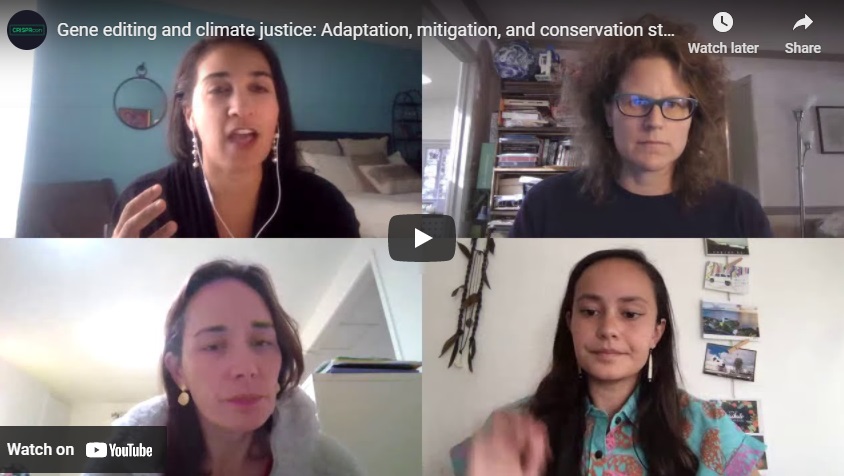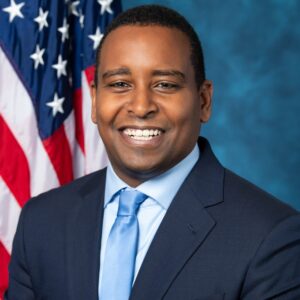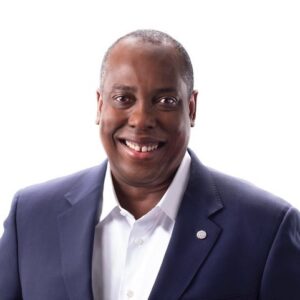CRISPRcon 2020 Revisited: Gene Editing and Climate Justice
CRISPRcon 2020 continued its fourth theme of equity, environment and agriculture by featuring a discussion on Oct. 15 on gene editing and climate justice. The panelists explored what is at stake—both risks and benefits—when using gene editing to address climate justice and climate equity issues for a variety of applications including invasive species, endangered species, and forest health.
The panelists started the discussion by first framing what climate justice is and how their organizations approach it. Katie Barnhill-Dilling, a postdoctoral research scholar at North Carolina State University who moderated the discussion, noted the diversity of perspectives on the panel and the unique viewpoints they brought to climate justice.
“One of the things I find most compelling about this combination of scholars and practitioners is there are so many layers to consider when they think about justice and whose justice – thinking about human and non-human nature alike and it’s a really compelling group of people to think about these hard questions,” said Barnhill-Dilling.
“Climate justice is the equitable sharing among all humans [of] the gifts of God’s creation regardless of racial or national background or status. It’s the holding to account of those whose domination or greed negatively impact others ability to rightly share in God’s creation,” said Alonso.
“As a social scientist, I want to hear what the public think and also what those vulnerable communities think. So, we try to focus on those groups of people who are vulnerable and who are likely to be impacted by future oriented technologies. So, we get to hear their voices now as the scientists are developing the technologies,” said Elizabeth Hobman.
“The primary interest of mine personally and also professionally is to try and rescue native forest tree species that are greatly impacted not only by climate change but also by these invasive pests that wouldn’t be here without some sort of globalization,” said Fitzsimons.
“Some of the limitations of engagement—it’s something we talk about a lot and feel good about inclusion…but we really have to operationalize what we mean by engagement or otherwise risk reifying some of the same inequities under the name of engagement. One thing I will emphasize on this topic is trying to look to communities as knowledge-holders and having situated expertise that’s absolutely crucial to engage in the questions we are asking about this research,” said Taitingfong.
Taitingfong highlighted her work engaging with Indigenous communities in Oceania, which she noted had similar findings to Hobman. The communities generally aren’t adverse to technology but did raise questions about who is funding the work, who are the scientists involved, and whether they have engaged with Indigenous communities. And in a similar vein, Alonso noted a sentiment from an earlier CRISPRcon panel raised by Krystal Tsosie, who moderated CRISPRcon 2020’s second panel on Indigenous perspectives in gene editing, about not mistaking suspicion of the technology as an aversion to technology. Alonso believes that assessment is a strong measuring stick for the vulnerable and marginalized communities she works with as it relates to emerging technology.
The panel also field questions from the audience about balancing the risks versus urgency to combat climate change, governance structure, and how to get more voices to the discussion on gene editing. The full panel discussion is below.


 Shelby Coffey III is a distinguished journalist, media executive, and thought leader whose career has helped shape the landscape of American news and public discourse. Over several decades, Coffey has held some of the most influential roles in journalism, including serving as editor of the Los Angeles Times, executive vice president of ABC News, and deputy managing editor of The Washington Post. His editorial leadership extended to key roles as president of CNN Financial News, editor of the Dallas Times Herald, and U.S. News & World Report.
Shelby Coffey III is a distinguished journalist, media executive, and thought leader whose career has helped shape the landscape of American news and public discourse. Over several decades, Coffey has held some of the most influential roles in journalism, including serving as editor of the Los Angeles Times, executive vice president of ABC News, and deputy managing editor of The Washington Post. His editorial leadership extended to key roles as president of CNN Financial News, editor of the Dallas Times Herald, and U.S. News & World Report. Effective March 1, 2025, Thomas J. Vilsack, former United States Secretary of Agriculture and Governor of Iowa, became the first Chief Executive Officer for the World Food Prize Foundation. In this new role, Governor Vilsack is focusing on expanding the Foundation’s global network, and will further position the Foundation as a leader in addressing global food and nutrition insecurity, continuing his lifetime of public service.
Effective March 1, 2025, Thomas J. Vilsack, former United States Secretary of Agriculture and Governor of Iowa, became the first Chief Executive Officer for the World Food Prize Foundation. In this new role, Governor Vilsack is focusing on expanding the Foundation’s global network, and will further position the Foundation as a leader in addressing global food and nutrition insecurity, continuing his lifetime of public service. Jerry Steiner has spent 40 years involved in agriculture following growing up on a Wisconsin dairy farm. He began his career with Monsanto, in multiple business leadership roles. From 2003-2013 he served as a member of the Executive team, as the company’s Executive Vice President of Sustainability and Corporate Affairs. He led the company’s global Government, Public and Industry Affairs teams across the 70 countries where Monsanto conducts business. This experience got Jerry connected to the Keystones centers work in agriculture. Key among his responsibilities were shaping the company’s public policy and building partnerships aimed at helping farmers around the world produce more food, while conserving valuable resources like water and energy. Two unique partnership that developed under his leadership were drought tolerant corn with 5 African countries, CIMMYT and the Gates foundation, and a building a sustainable business model in Brazil with the value chain leading to significant multi-company investment and soybean varieties that can protected themselves.
Jerry Steiner has spent 40 years involved in agriculture following growing up on a Wisconsin dairy farm. He began his career with Monsanto, in multiple business leadership roles. From 2003-2013 he served as a member of the Executive team, as the company’s Executive Vice President of Sustainability and Corporate Affairs. He led the company’s global Government, Public and Industry Affairs teams across the 70 countries where Monsanto conducts business. This experience got Jerry connected to the Keystones centers work in agriculture. Key among his responsibilities were shaping the company’s public policy and building partnerships aimed at helping farmers around the world produce more food, while conserving valuable resources like water and energy. Two unique partnership that developed under his leadership were drought tolerant corn with 5 African countries, CIMMYT and the Gates foundation, and a building a sustainable business model in Brazil with the value chain leading to significant multi-company investment and soybean varieties that can protected themselves. Jennifer Morris is the Chief Executive Officer of The Nature Conservancy, leading a team of nearly 6,000 staff working in more than 80 countries and territories tackling the dual crises of the
Jennifer Morris is the Chief Executive Officer of The Nature Conservancy, leading a team of nearly 6,000 staff working in more than 80 countries and territories tackling the dual crises of the  Congressman Joe Neguse represents Colorado’s 2nd District in the U.S. House of Representatives. He was elected to his first term in November 2018, becoming the first Black Member of Congress in Colorado history. In December 2022, Rep. Neguse was elected by his colleagues to serve as Chair of the Democratic Policy and Communications Committee (DPCC), becoming the first Coloradan to serve in a senior elected leadership role in the House in over 85 years. He serves on the Natural Resources and Judiciary Committees, and was also appointed by House Minority Leader Hakeem Jeffries to serve as one of four Democrats on the prestigious Rules Committee. Rep. Neguse serves as Ranking Member on the House Subcommittee on Federal Lands, which he previously Chaired in the 117th Congress.
Congressman Joe Neguse represents Colorado’s 2nd District in the U.S. House of Representatives. He was elected to his first term in November 2018, becoming the first Black Member of Congress in Colorado history. In December 2022, Rep. Neguse was elected by his colleagues to serve as Chair of the Democratic Policy and Communications Committee (DPCC), becoming the first Coloradan to serve in a senior elected leadership role in the House in over 85 years. He serves on the Natural Resources and Judiciary Committees, and was also appointed by House Minority Leader Hakeem Jeffries to serve as one of four Democrats on the prestigious Rules Committee. Rep. Neguse serves as Ranking Member on the House Subcommittee on Federal Lands, which he previously Chaired in the 117th Congress. Llewellyn King was born in Southern Rhodesia, now Zimbabwe. He went into journalism as soon as he turned 16, stringing for Time magazine and United Press in Africa.
Llewellyn King was born in Southern Rhodesia, now Zimbabwe. He went into journalism as soon as he turned 16, stringing for Time magazine and United Press in Africa. Steven Williams is the Chief Executive Officer of PepsiCo North America, overseeing a more than $48 billion business that spans PepsiCo’s Foods and Beverage operating units. His leadership encompasses more than 125,000 associates and over 900 locations across the U.S. and Canada. Steven joined PepsiCo in 2001 as part of PepsiCo’s acquisition of the Quaker Oats Company, which he joined in 1997, and has held leadership positions of increased responsibility since.
Steven Williams is the Chief Executive Officer of PepsiCo North America, overseeing a more than $48 billion business that spans PepsiCo’s Foods and Beverage operating units. His leadership encompasses more than 125,000 associates and over 900 locations across the U.S. and Canada. Steven joined PepsiCo in 2001 as part of PepsiCo’s acquisition of the Quaker Oats Company, which he joined in 1997, and has held leadership positions of increased responsibility since.